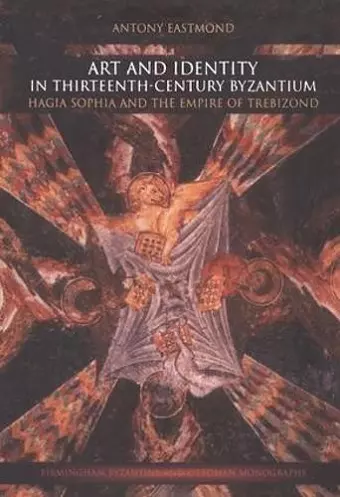Art and Identity in Thirteenth-Century Byzantium
Hagia Sophia and the Empire of Trebizond
Format:Hardback
Publisher:Taylor & Francis Ltd
Published:20th Oct '04
Currently unavailable, our supplier has not provided us a restock date

The church of Hagia Sophia in Trebizond, built by the emperor Manuel I Grand Komnenos (1238-63) in the aftermath of the fall of Constantinople to the Fourth Crusade, is the finest surviving Byzantine imperial monument of its period. Art and Identity in Thirteenth-Century Byzantium is the first investigation of the church in more than thirty years, and is extensively illustrated in colour and black-and-white, with many images that have never previously been published. Antony Eastmond examines the architectural, sculptural and painted decorations of the church, placing them in the context of contemporary developments elsewhere in the Byzantine world, in Seljuq Anatolia and among the Caucasian neighbours of Trebizond. Knowledge of this area has been transformed in the last twenty years, following the collapse of the Soviet Union. The new evidence that has emerged enables a radically different interpretation of the church to be reached, and raises questions of cultural interchange on the borders of the Christian and Muslim worlds of eastern Anatolia, the Caucasus and Persia. This study uses the church and its decoration to examine questions of Byzantine identity and imperial ideology in the thirteenth century. This is central to any understanding of the period, as the fall of Constantinople in 1204 divided the Byzantine empire and forced the successor states in Nicaea, Epiros and Trebizond to redefine their concepts of empire in exile. Art is here exploited as significant historical evidence for the nature of imperial power in a contested empire. It is suggested that imperial identity was determined as much by craftsmen and expectations of imperial power as by the emperor's decree; and that this was a credible alternative Byzantine identity to that developed in the empire of Nicaea.
'This précis of Eastmond's arguments does no justice to the subtlety of his case or the wealth of his examples. I started from a position of scepticism, but found myself following the argument with fascination. I commend this book to all serious students of Byzantine monuments, and Byzantine political theory.' The Anglo-Hellenic Review 'Thorough annotation and indexing, plus a helpful chronological table of regional thirteenth-century rulers, round out a very worthwhile and balanced addition to university and Byzantinophile libraries.' Religion and the Arts ’The book is lucidly written and well structured, using numerous photographs, many of which are in colour, and some useful sketches of the less visible paintings to illustrate the text... it is definitely a good read.’ Art History ’Antony Eastmond writes with authority and clarity... This book [...] is dense and layered but will amply reward the careful reader. The complexity of the subject is eased by abundant illustrations - 102 black and white figures and 21 color plates... The bibliography is a model of its type, and the index is complete and well-ordered.’ Church History ’This long-awaited work is an excellent study of a key monument in Byzantine art and culture. ... The book is lavishly produced with good black and white and coloured photographs. The generous number of the colour plates is eminently laudable. Equipped with useful appendices, indexes and ample annotations, Eastmond's study of the church of St Sophia contributes significantly to the reappraisal of the monument, setting the tone for similar publications/studies and making a lasting contribution to the field.’ Byzantinische Zeitschrift
ISBN: 9780754635758
Dimensions: unknown
Weight: 748g
246 pages